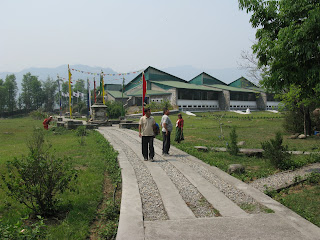The beauty, they say, lies in the eyes of a beholder. That might be true to something beautiful, but what you want to tell about something sublime. If there is something that challenges Biblical Garden of Eden in its splendor and magnificence, it’s Pokhara – the ultimate destination for the wanderlusts and those who appreciate, of course, beauty in its pristine glory.
The enchanting valley of Pokhara valley is situated at an altitude of 827 meters from sea level. An incarnation of the religious heaven, this celestial city is also known as the “city of seven lakes”. Just 200 kilometers west of Kathmandu, it is linked by Air and by road from Kathmandu and the Indian border Sunauli. Pokhara offers magnificent views of Dhaulagiri, Fishtail, Manaslu, five peaks of Annapurna and others. This is one of the few places in the world to provide such a dramatic view in a sub-tropical setting. The nearest snow-capped mountain, Fishtail, is less then 30 kilometers from Pokhara. Pokhara's numerous lakes offer fishing, boating and swimming. पोखरा फोटो ग्यालरी- पोखरा उपमहानगरपालिका पोखरा उपत्यकामा अवस्थित नेपालको अत्यन्तै रमणीय स्थानको रुपमा परिचित छ । यसैले यसलाई नेपालको एक महत्वपूर्ण पर्यटकीय स्थलको रुपमा पनि लिने गरिन्छ || Places to See in Pokhara
Fewa Lake:
Fewa Lake, the second largest lake in the Kingdom, and is the center of all attraction in Pokhara. It is the largest and most enchanting of the three lakes that add to the resplendence of Pokhara. Here, one can sail or row a hired boat across to the water or visit the island temple in its middle. The eastern shore, popularly known as lakeside or Baidam, is the favorite home base for travellers and is where most of the hotels, restaurants and handicraft shops are located.
Barahi Temple:
The Barahi temple is the most important monument in Pokhara, Built almost in the center of Fewa Lake, this two-storied pagoda is dedicated to the boar manifestation of Ajima, the protectress deity representing the female force Shakti. Devotees can be seen, especially on Saturdays, carrying male animals and fowl across the lake to be sacrificed to the deity.
Barahi Temple:
The Barahi temple is the most important monument in Pokhara, Built almost in the center of Fewa Lake, this two-storied pagoda is dedicated to the boar manifestation of Ajima, the protectress deity representing the female force Shakti. Devotees can be seen, especially on Saturdays, carrying male animals and fowl across the lake to be sacrificed to the deity.
Seti River:
Another of Pokhara's natural wonders that unfailingly interests visitors is the Seti Gandaki river. Flowing right through the city, the boisterous river runs completely underground at places. Amazingly, at certain points the river appears hardly two meters wide. But its depth is quite beyond imagination - over 20 meters! Mahendra Pul, a small bridge near the old Mission Hospital, provides a perfect view of the rivers's dreadful rush and the deep gorge made by its powerful flow
Devi's Fall:
Another of nature's wonders in Pokhara is the Mahendra Gupha. This large limestone cave is locally known as the House of Bats, an apt name for it. A two-hour walk to the north of Pokhara, it is best to bring your own torch to see the stalactites and stalagmites, as well as the local winged residents.
Another of Pokhara's natural wonders that unfailingly interests visitors is the Seti Gandaki river. Flowing right through the city, the boisterous river runs completely underground at places. Amazingly, at certain points the river appears hardly two meters wide. But its depth is quite beyond imagination - over 20 meters! Mahendra Pul, a small bridge near the old Mission Hospital, provides a perfect view of the rivers's dreadful rush and the deep gorge made by its powerful flow
Devi's Fall:
Locally known as the Patale Chhango (Hell's Fall). Devi's Fall (also known as Devin's and David's) is a lovely waterfall lying about two km south-west of the Pokhara airport on the Siddhartha Highway. Legend has it that a trekker (Devin, David..) was washed away by the Pardi Khola and mysteriously dis appeared down into an underground passage beneath the fall.
Pokhara's traditional bazaar is colorful and so are its ethnically diverse traders. Located about four km from Lakeside, the market's original charm is alive and well. This area strewn with shops selling commodities from edibles and cloth to cosmetics and gold is a pleasant and shady spot to stroll around.
The old bazaar is also home to one of Pokhara' s most important shrines. Locally called the Bindhyabasini Mandir, this white dome-like structure dominates a spacious stone-paved courtyard built atop a shady hillock. It is dedicated to Goddess Bhagwati, yet another manifestation of Shakti. The park-like grounds offer a fine picnic area, and on Saturdays and Tuesdays when devotees flock there to offer sacrifices, it takes on a festive local flavor.











FANTASIC GOOD PHOTO
ReplyDelete